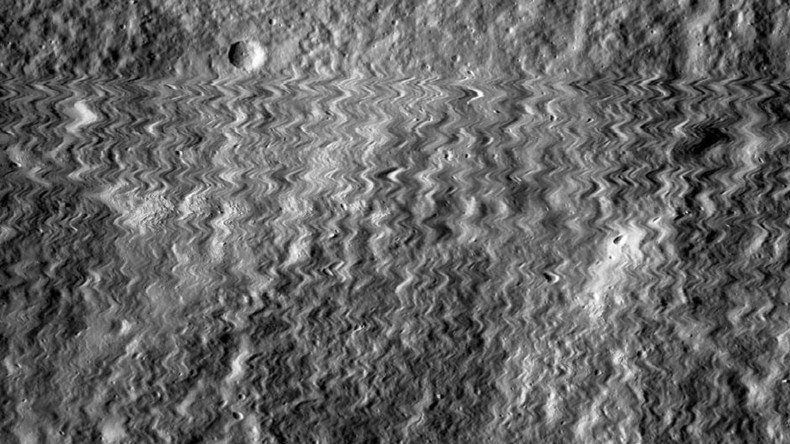Lunar camera whacked by ‘speeding bullet’ meteorite produces ‘jittery’ pictures

NASA scientists were stumped when the usually impeccable camera on the Lunar Reconnaissance Orbiter produced a “wild and jittery” photo of the moon’s surface.
The unusual photo features a squiggly pattern that the NASA team didn’t initially understand. They quickly figured out, however, that the orbiter must have been hit by something as it was travelling through space.
The orbiter’s camera system (LROC) consists of three cameras mounted on the spacecraft. Two are narrow angle cameras which capture high-resolution black and white images, while the third is a wide-angle camera that takes moderate resolution photos.
NASA’s Lunar Orbiter (@LRO_NASA) was hit by a meteoroid and survived. Read more: https://t.co/CT79o73db7pic.twitter.com/PTMNZaTUnh
— NASA Goddard (@NASAGoddard) May 28, 2017
LROC researchers concluded that there must have been a brief violent movement of the left Narrow Angle Camera (NAC).
There were no spacecraft events, such as solar panel movements or antenna tracking, that might have caused such a jitter during this period. “Even if there had been, the resulting jitter would have affected both cameras identically,” explained Mark Robinson, principal investigator of LROC at Arizona State University’s School of Earth and Space Exploration.
READ MORE: Lunar surprise: Astronomers discover moon orbiting ‘Snow White’ dwarf planet
“The only logical explanation is that the NAC was hit by a meteoroid,” Robinson said. “The meteoroid was traveling much faster than a speeding bullet... In this case, LROC did not dodge a speeding bullet, but rather survived a speeding bullet!”
A tweet from the orbiter’s official Twitter account sought to reassure people that it didn’t suffer any lasting damage in the collision.
I'm a surviver. :o) https://t.co/KulrGI8fCJ
— NASA Lunar Orbiter (@LRO_NASA) May 26, 2017
Robinson explained that it’s extremely rare for such an event to show up in the photos that LROC produces.
The camera system typically only captures images during daylight and at that, it’s for less than three hours, so for the camera to be hit by a meteor during the time that it was also capturing images is "statistically unlikely."
"A meteoroid impact on the LROC NAC reminds us that LRO is constantly exposed to the hazards of space," said Noah Petro, deputy project scientist from NASA Goddard. “And as we continue to explore the moon, it reminds us of the precious nature of the data being returned."












